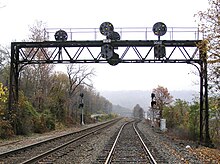North American railroad signals
Individual railroad corporations are free to devise their own signaling systems as long as they uphold some basic regulated safety requirements.In most situations, especially where bi-directional running was implemented, signals needed to be mounted above the track or on bracket masts to allow this right hand placement.Incandescent signals use a doublet lens combination to directionally focus their small power out over a long range (3,500 ft or 1,100 m in daylight.)[2]: 171 By the end of the 19th century, particularly as trains became longer and faster, and railroad lines grew more congested, the banjo signal was considered to have a single and terminal flaw: visibility.The need to maintain air pressure in the long pneumatic lines eventually led the railroads to discontinue their widespread use as automatic block signals.By the early 1890s more railroads began installing electric motor-operated semaphore signals, which were visible at distances of thousands of feet, during the day and under inclement weather conditions.The intent was to reduce the chance of a malfunction or snowfall causing the signal to only partially rise towards the horizontal, yet still displaying the most restrictive color night indication.Color images of these signals bear this out as the "Red-Red-Green" of the home and "Yellow-Yellow-Green" of the distant arms were universal used on 60 and 75 degree (B&M, Central Vermont) L.Q.He then turned his attention to medium- and long-range daylight signals using the same incandescent electric lamps with greatly improved optics: the "Doublet-Lens" combination.The early color light signals were visible for only about half that distance (2,500 feet or 760 metres) while using about the same electrical current, then a major concern in "primary battery territory".By 1925, the development of "high-transmission colors" of railroad glassware by Gage and Corning Glass improved this limited distance to an acceptably competitive 3,500 feet (1,100 m) on tangent track.In the UK, original electromechanical searchlight signals consisted of a low-power incandescent bulb mounted behind a semaphore spectacle devoid of a blade behind a target.The first such product, marketed in 1968 as the "Unilens" by Safetran, uses fiber optics to concentrate the output of up to four light sources behind a single lens.However, other than as low-speed signals requiring only short-range visibility, these have not been entirely successful and most are now being removed from mainline service after a relatively short working life.They were one of the first widely used type of high intensity color light signal, notably adopted by the New York Central and Seaboard Coast Line railroads, and later used exclusively by Conrail and New Jersey Transit.[3] The original General Railway Signal (GRS) Type "G" design consisted of a cast iron box containing three doublet lens units in a triangular arrangement.Development of the doublet lens by Churchill at Corning Glass Works allowed an electric light source to be more effective than with previous daytime colorlight signal designs.Over time, due to its low cost and versatility, the modular color light signal became the standard in North America.Today the most popular type of new signal in North America is a modular design manufactured by Safetran, as it is the cheapest, with all of the four major Class 1 railroads installing it almost exclusively.These extended signal shades improves visibility in bright sunny conditions and blocks other light from other sources that could illuminate and provide a false aspect to the engineer.A light yellow tinted conical glass with frosted tip was chosen, as this color was determined to have the highest visibility under fog conditions based on empirical studies at Corning at that time.US&S was the sole supplier of classic position light equipment as this manufacturer's factory was formerly located on the four track mainline of the PRR in Swissvale, Pennsylvania.[5] In 1954, the PRR experimented installing red lenses in the horizontal position of the upper head to help increase the at distance visibility of absolute Stop signals at Overbrook interlocking.[6] Under the Penn Central and later Conrail it became standard practice to add these red lenses to high position lights and even some pedestal signals.[7] The CPL consists of a central position target with up to four pairs of doublet lens units around the perimeter of the background disc.The lens units are spaced at 45-degree axes using the positions: green |, yellow /, red — and a lunar white \ for restricting also being present in some installations.[7] As of 2008[update] and as with all U.S. railroads, CSX is slowly replacing all of the remaining CPLs on its system with contemporary vertical color light LED signals.The sole exception is the Staten Island Railroad, which recently upgraded its signaling system with new CPLs using modern Safetran position light equipment.[2]: 146–147 A banjo-shaped wooden case housed a large iron wire hoop with red silk stretched and glued over it.When the coil was energized, the wire hoops were moved away from the large glass opening in the front of the wooden "banjo" case exposing its white-painted interior.













North American railway signalingBaltimore and Ohio RailroadMagnolia, West Virginiarailroad signalslocomotive operatorEastern United StatesClass 1 railroadsUnited StatesUnion PacificNorfolk SouthernAmtrakCanadian railroadsinterlockingtrain dispatchertrack circuitstrain order signalsmanual blockslide fencessidingsSpringfield, MassachusettsPennsylvania Railroadcatenarybi-directionalincandescent lampsdoublet lensderailsInterstate Commerce Commissionrestrictiverapid transitBaltimore Metro SubwayLinkWashington MetroPATCO Speedlineturnoutsfault toleranceRailway signalRailway semaphore signalAtchison, Topeka and Santa Fe RailwayUnion Switch & Signal companyCanadian NationalWinnipegHall Signal CompanyCornell UniversityCorning Glass Worksprimary batterySafetranfiber opticsSeaboard Coast LineConrailNew Jersey TransitGeneral Railway SignalTN Pass LineNew York Penn StationChesapeake and OhioSouthern RailroadrailfansDarth VaderStar WarsTrenton, New JerseyMain LinePhiladelphiacandlepowertoric lensFresnel lensSuburban StationLong Island Rail RoadNorfolk and WesternSwissvale, PennsylvaniaPenn CentralBaltimore, MarylandBaltimore and OhioStaten Island RailwayStaten Island RailroadChicago and Alton RailroadChicago Union StationChicago Northwestern StationAlton RailroadChicagoNewcastle and Frenchtown Turnpike and Rail RoadNew York and New Haven RailroadReading Railroadelectromagnetkerosene lampStamford, Connecticuttrack circuitDr. William Robinsonautomatic block signalEastern RailroadBoston & Mainerailway museumsAutomatic Blockdistant signalcab signalingabsolute blockRiverLINE1996 Maryland train collisionFederal Railroad Administrationpush-pull trainlocomotive engineerscab signalsCab signallingRailway signallingSignalling block systemBlock systemsAbsolute block signallingAutomatic block signalingCentralized traffic controlCommunications-based train controlDirect traffic controlEuropean Train Control SystemMoving blockRadio Electronic Token BlockTrack Warrant ControlTrain order operationSignalling controlBlock postIntegrated Electronic Control CentreLever frameRail operating centreSolid State InterlockingWestlock InterlockingSignalsApplication of railway signalsAxle counterTrack circuit interrupterTreadleTrain protection
